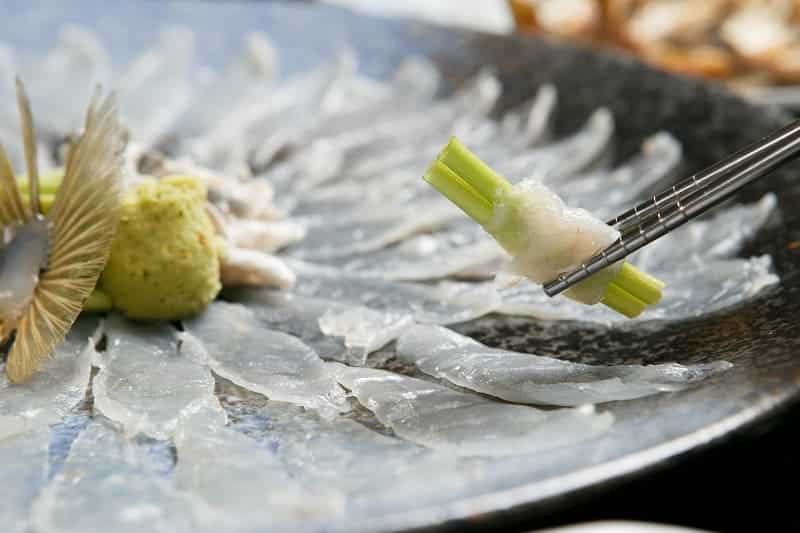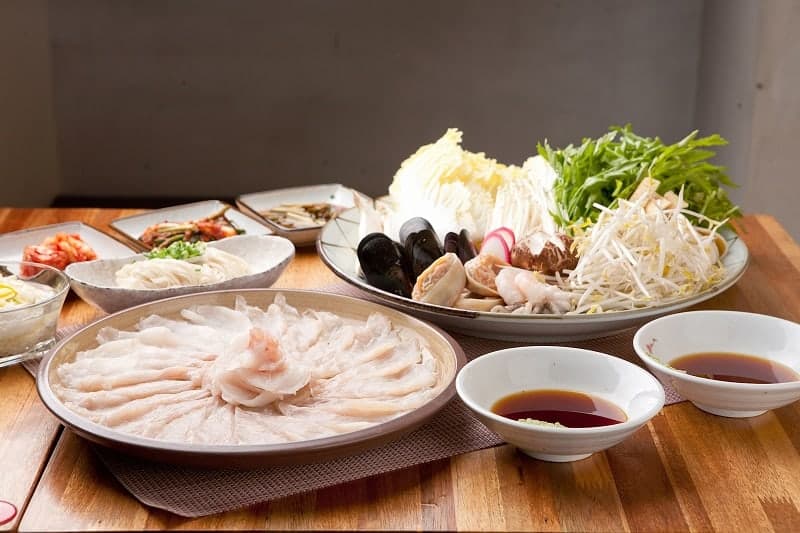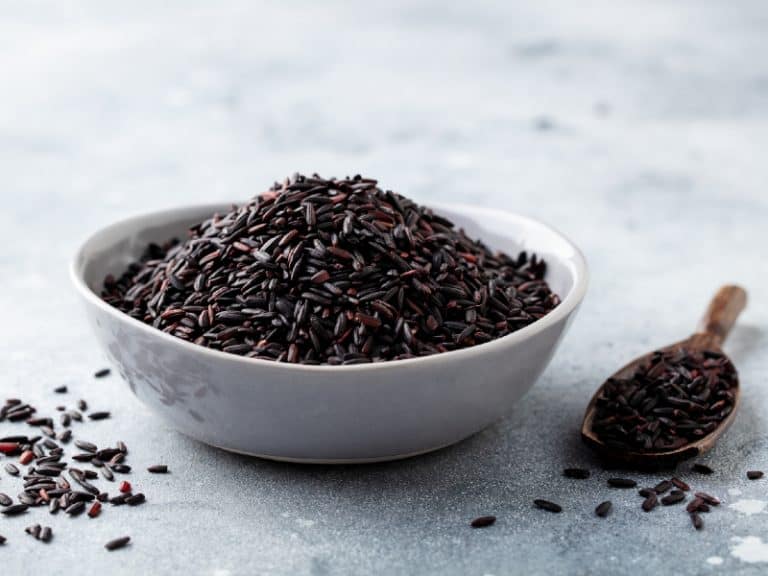What Does Fugu Taste Like? How to Try Fugu Pufferfish
Fugu, also known as blowfish or puffer fish, has a mild, clean flavor. Some say its taste is so subtle that it doesn’t bring seafood to mind at all.
In Japan, that’s one of the reasons fugu is sought after.
Its texture is something between sea bass and squid. It’s chewy when raw, but when cooked, its flesh is delicate.
A very lean fish, fugu needs minimal cooking, or it will become unpleasantly tough.
You’d think that an almost tasteless fish wouldn’t have a great place in the kitchen, but there are dozens of ways to cook fugu, and chefs jealously guard their recipes.
The chef may quickly sear the fillet to brown the outside but leave the interior raw. This calls for a garnish of ponzu sauce, grated ginger, or tangy daikon radish.
Fugu meat rolled into balls, coated in flour and deep-fried is known as karaage. It’s a popular snack to go with alcohol.
Karaage has a crunchy coating with the flesh inside remaining soft. It’s served with a splash of lemon juice, yuzu, or ponzu.
Fugu lovers claim that the meat from around the fish’s mouth is the best for deep frying.

Fugu skin is popular when deep-fried and served in salads, or as slices to dip into the sauce. Parboiled and finely sliced, fugu skin is known as kawasashi.
Kawasashi is a popular appetizer taken when drinking sake. It is gelatinous and a little crunchy. The gelatinous quality of fugu skin is exploited in other dishes. For example, a broth made of the skin and vegetables adds richness and flavor to cold soba noodles.
Tecchiri, or fugu hot pot, is also popular. It consists of fugu flesh, skin and bones, cooked in a clay pot with vegetables and mushrooms in a dashi broth.
Dashi is a basic broth made from bonito flakes, dried sardines, dried shiitake mushrooms, dried shrimp, dried scallops, adzuki beans and toasted soybeans. There are simpler versions, including one based on kombu seaweed only.
Fugu rice gruel is made of rice cooked in the dashi broth left in the hot pot after the fish and vegetables have been eaten. Lots of flavor with no bit of fugu wasted, especially if you use wild rice.
The milt, or roe of fugu, has a short season in Spring and is eagerly sought after as a delicacy in Japan. It’s compared to creamy mild cheese, only without the flavor of dairy.
Fugu roe is often charcoal grilled and served with a little salt. Roe is also eaten raw, or deep-fried in tempura batter.
Fugu sushi is prepared either in the familiar rolled form or as a sort of cake where a slice of fish is placed on top of the seasoned rice. Sushi is accompanied by grated daikon radish with chili, scallions, ponzu sauce, or other condiments to dip into.
A luxurious sake is flavored with sun-dried fugu fins. The fins are cooked and added to warm sake.
The sake gains an unusual, smoky flavor from the fugu skin.
One of the most popular ways of serving fugu is called sashimi or Tessa. The chef slices the raw fillet so thinly that the pattern of the plate is visible under the transparent slices.
Fugu sashimi is for those who want to experience the fish and only the fish, with its mild flavor and chewy texture. But often a side dish of grated daikon radish, ponzu sauce, or soy sauce is served on the side, to provide a little flavor punch.
The way to eat Tessa is to pick up several slices at once and dip them into the sauce provided.
Fugu sashimi may be presented in various artistic ways. The transparent slices may be arranged to resemble a peony, a crane, a turtle, or a chrysanthemum.
The chrysanthemum is a symbol of death in Japan. Fugu presented as a chrysanthemum is meant to bring a delightful shiver to the diner because fugu in its natural state is mortally poisonous.
The eyes, spikes, ovaries and liver contain tetrodotoxin, a poison so deadly that even the slightest trace of it can kill a person. To make the skin edible, the spikes are pulled out.
Tetrodotoxin is 1200 times more poisonous than cyanide. Each fugu contains enough of it to kill 30 people.
It’s forbidden to the Emperor of Japan to eat fugu, and it’s easy to see why. Fugu is the only food falling under this law.
Fugu isn’t a dish for amateurs. The Tokyo Bureau of Social Welfare and Public Health reported 20 to 44 incidents of fugu poisoning per year between 1996 and 2006, all coming from the kitchens of home cooks.
To legally cook fugu, a chef must train for two years, receive certification, and use knives set aside for fugu alone. Chefs who handle fugu undergo regular examinations, and only licensed restaurants serve the fish.
A fugu chef is always aware that a single wrong move may spell death for a customer. The toxic parts are so dangerous that they are never just thrown in the garbage, but disposed of and burnt according to directions set down by law.
When the chef has removed all the toxic parts of the fish, he places them in a designated metal drum that locks. At the end of his shift, he or his assistant takes the drum to a special facility in the Tokyo fish market to be incinerated.
If you’re curious to know how a specialized chef prepares fugu to be edible, this is how it’s done:
Check Also: What Do Ostrich Eggs Taste Like?
Note: even if you have the unlikely opportunity, you should never try to gut or make a fugu edible yourself. Ninety percent of fugu poisonings are caused by amateur home cooks who prepared the fish themselves.
Remember that a chef studies and practices four and even up to six years to be licensed.
First, the chef removes spikes on the skin, which are poisonous.
Then, the chef makes a cut around the fish’s mouth. This lets him pull the skin off in one piece.
The skin has no scales, so it doesn’t need to be cleaned up for cooking except for a good rinse. It’s put aside to fry as a snack to accompany sake.
The gel on the body is then rubbed with salt and washed off.
The eyes, which are also toxic, are then removed.
Here’s one of the most dangerous steps: gutting the fish. If the ovaries or liver are punctured, the poisonous substance in them will spread into the flesh.
If that happens, the whole fish goes into the special metal garbage drum to be incinerated.
Once the chef is sure that all poisonous pieces have been removed, he fillets the fugu.
The head may be sliced into two or three pieces, and boiled in a stew or hotpot.
People who eat fugu are seeking a thrill. It’s also said that consuming a minuscule amount of the toxin produces a calm, high feeling.
Some people have committed suicide by eating the toxic parts of fugu. And some who eat fugu, even one properly prepared and safe, claim they feel that their lips went numb after dining.
It’s said that in those cases, a trace of poison remained in the flesh, although it’s not likely. If that were so, the throat and stomach would also feel numb.
Fugu poisoning brings on complete paralysis, in stages, until death. The unfortunate patient remains conscious through all the process.
The European Union has banned the sale of fugu. Fewer than 20 restaurants in the US serve fugu, most located in New York.
Fugu is now being bred to be free of tetrodotoxin and thus harmless. The problem is that eager diners aren’t interested in fugu if it’s just another harmless fish.
And Japan’s National Fugu Association refuses to allow serving fugu liver, even if the fish has been specially raised toxin-free.
It’s essential to order fugu only in restaurants displaying updated licenses to serve it. This is part of the reason that fugu dishes are expensive.
Other reasons include the fact that a licensed chef must have trained in fugu cookery for at least two years and more often, four to six years. Fugu chefs are considered the elite of Japan’s culinary world.
A fugu chef may have started learning as a teenager, but will only be allowed to take the licensing test at age 20. One-third of the test applicants fail.

Fugu cuisine isn’t available everywhere in Japan. You must seek fugu specialty shops and traditional high-end restaurants to find it.
You can order a single fugu dish, or go for a full fugu menu. It will depend on how much you’re willing to pay for the experience.
Fugu dishes can cost $100 and more.
Rules regarding the availability of fugu have been relaxed. It’s possible now to buy ready-prepared, safe fugu even in some supermarkets.
This has caused outrage among fugu chefs, who have spent years perfecting their craft and personally spent thousands of yen on the fish they trained on.
Today there are about 3,800 fugu restaurants in Japan.





